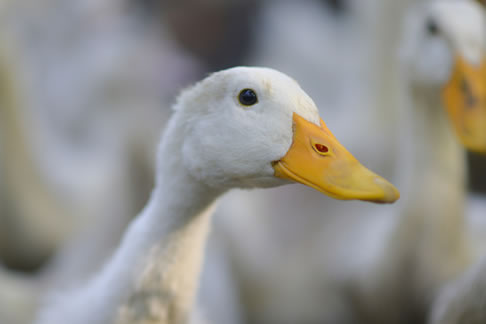Did you know that Mallard ducks can live up to 20 years in the wild? Or that ducks and geese are intelligent, emotional and caring creatures who learn quickly and mourn the loss of a mate or loved one?
Origin
Nearly all domestic ducks descend from the mallard duck or the Muscovy duck. And in Europe, western Asia, and Northern Africa, the domesticated goose was derived from the graylag goose — while in eastern Asia, it was derived from the swan goose.
We can trace evidence of domesticated geese going as far back in time as over 4,000 years ago in Egypt.
Natural Needs, Tendencies and Preferences
Geese in the wild fly (migrate) great distances — thousands of miles twice a year. Amazingly, Canadian geese can fly as much as 16 hours per day at speeds of 60 mph or 960 miles a day, and as high as 30,000 feet. They fly in a V formation as it saves their energy by benefiting from the wing tip vortex of the bird flying in front.
Both of these birds travel in large groups (flocks), and multiple families will form a close group and migrate together.
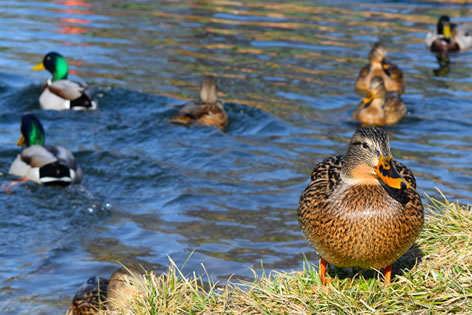 In the wild, a female duck sits on her eggs to protect them and keep them warm; her eggs will usually hatch within 28 days. Mother ducks are protective and caring of their young.
In the wild, a female duck sits on her eggs to protect them and keep them warm; her eggs will usually hatch within 28 days. Mother ducks are protective and caring of their young.
Ducks enjoy a variety of food including grass, fish, aquatic plants, worms, plants, and insects. They like to keep themselves and their nests clean.
Wild ducks can live up to 20 years, while Canadian geese can live up to 30 years in the wild.
Ducks emit a wide range of calls including whistles, grunts, coos, quacks, and other sounds to communicate a variety of situations or feelings. Ducks are intelligent, emotional and caring creatures. They learn quickly; newborn ducks can swim after only a few hours from birth — and can travel without their mother to locate water on their own if necessary. Ducks also see in color and have eyesight and view similar to that of humans.
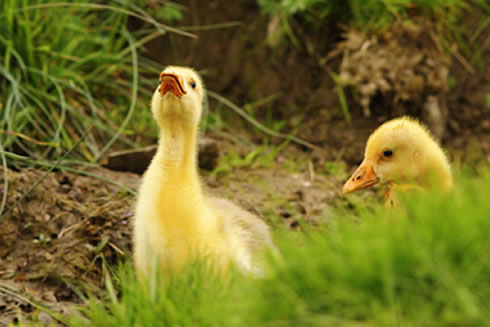 Geese are sensitive to unusual movements and can help to protect a property (similar to a watch dog). And geese are also very sensitive and intelligent — and they mate for life. They exhibit signs of extreme mourning at the loss of a mate or loved one — similar to humans.
Geese are sensitive to unusual movements and can help to protect a property (similar to a watch dog). And geese are also very sensitive and intelligent — and they mate for life. They exhibit signs of extreme mourning at the loss of a mate or loved one — similar to humans.
What’s Changed — A Duck’s or Goose’s Life Today
Farmers raise ducks for their meat, eggs, and feathers. And hunters still pursue wild ducks and geese frequently across most areas of the U.S. and Canada for food and/or sport.
And producers raise both of these birds to create “foie gras,” a product created from diseased duck or goose liver. Farmers force over four pounds of corn mush down the duck and geese throats through a long metal pipe twice each day for two to three weeks until they can barely move and are on the verge of organ rupture and death. By then, the birds’ livers have swelled up to twelve times their healthy size.
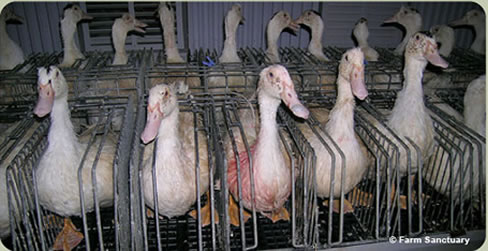
The meat industry sells the down feathers of the birds — either collected post-slaughter or plucked from the live birds. The process of plucking feathers from a bird while it is alive is also extremely cruel and abusive; many of the ducks and geese suffer unbearable pain, wounding, and in many cases, death. And if they somehow survive the first round, pluckers subject them to the same treatment several more times.
What Happens Next for Ducks and Geese
Due to the extremely cruel and abusive methods used to obtain it, a number of countries and cities have now banned the force feeding of ducks and geese for foie gras. Where it is legal, many retailers now refuse to carry it. Besides, at 12 grams of fat and 42 mg of cholesterol per ounce, it can hardly be considered a healthy food choice for humans.
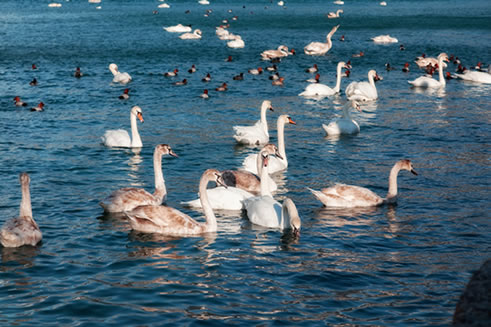 And even though the plucking of live birds for feathers is now outlawed in the U.S. and several European countries, the cruel practice still occurs in China –where anywhere from 50 to 80 percent of the world’s down market comes from live-plucked birds. Some clothing and bedding manufacturers have consequently started to take steps to ensure their down suppliers are not obtaining product by live-plucking ducks or geese.
And even though the plucking of live birds for feathers is now outlawed in the U.S. and several European countries, the cruel practice still occurs in China –where anywhere from 50 to 80 percent of the world’s down market comes from live-plucked birds. Some clothing and bedding manufacturers have consequently started to take steps to ensure their down suppliers are not obtaining product by live-plucking ducks or geese.
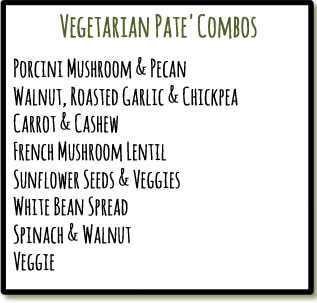 In conclusion, as more people become aware of the cruel treatment these sensitive and intelligent birds are subjected to on a regular basis, the demand for their feathers, meat and livers will surely decrease.
In conclusion, as more people become aware of the cruel treatment these sensitive and intelligent birds are subjected to on a regular basis, the demand for their feathers, meat and livers will surely decrease.
Gory Details / Other Articles
http://www.peta.org/issues/animals-used-for-food/animals-used-food-factsheets/pain-behind-foie-gras/
http://gentleworld.org/how-down-feathers-are-collected/
http://www.veganpeace.com/animal_cruelty/downandfeathers.htm
http://aldf.org/cases-campaigns/features/duck-duck-goose
Sources for this Article
Duck; Wikipedia
Foie gras; Wikipedia
Foie gras; http://www.answers.com

